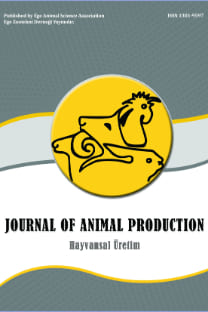Kalıtımın Epigenetik Boyutunda DNA Metilasyon Desenleri
DNA Methylation Patterns in Epigenetic Context of Inheritance
___
- Bartolomei, M.S., Zemel, S., Tilghman, S.M. 1991. Parental imprinting of the mouse H19 gene. Nature 351: 153-155.
- Coolen, M.W., Statham, W.L., Qu, W., Campbell, M.J., Henders, A.K., Montgomery, G.W., Martin, N.G., Susan, C.J. 2011. Impact of the genome on the epigenome is manifested in DNA methylation patterns of imprinted regions in monozygotic and dizygotic twins. PLoS ONE 6(10): e25590.
- De Smet, C., Lurquin, C., Bernard, L., Martelange, V., Boon, T. 1999. DNA methylation is the primary silencing mechanism for a set of germ line- and tumor-specific genes with a CpG-rich promoter. Mol. Cell. Biol. 7327-7335.
- Doherty, A.D., Mann, M.R.W., Tremblay, K.D., Bartolomei, M.S., Schultz, R.M. 2000. Differential effects of culture on imprinted H19 expression in the preimplantation mouse embryo. Biol. Reprod. 62: 1526-1535.
- Eads, C.A., Laird, P.W. 2002. Combined bisulfite restriction analysis (COBRA). Ed. Mills, K. I., Ramsahoye, B. H. DNA methylation protocols. Humana Press, New Jersey, s. 71-86.
- Falls, J.G., Pulford, D.J., Wylie, A.A., Jirtle, R.L. 1999. Genomic imprinting: implications for human disease. Am. J. Pathol. 153: 635-647.
- Frommer, M., Mcdonald, L.E., Millar, D.S., Collis, C.M., Watt, F., Grigg, G.W., Molly, P.L., Paul, C.L. 1992. A genomic sequencing protocol that yields a positive display of 5-methylcytosine residues in individual DNA strands. Genetics, Proc. Nati. Acad. Sci. 89: 1827-1831.
- González-Recio, O. 2011. Epigenetics: a new challenge in the post-genomic era of livestock. Frontiers in Genetic. 2(106): 1-4.
- Heijmans, B.T., Tobia, E.W., Steinb, A.D., Putterc, H., Blauwd, G.J., Sussere, E.S., Slagbooma, P.E., Lumeye, differences associated with prenatal exposure to famine in humans. PNAS 105: 17046-17049.
- Herman, J.G., Graff, J.R., Myohanen, S., Nelkin, B.D., Baylin, B.S. 1996. Methylation-specific PCR: A novel PCR assay for methylation status of CpG islands. Proc. Natl. Acad. 93: 9821-9826.
- Jurkowski, T.P., Jeltsch, A. 2011. On the evolutionary origin of eukaryotic DNA methyltransferases and DNMT2. PLoS ONE 6(11): e28104.
- Khatib, H. 2012. Livestock Epigenetics. Wiley- Blackwell, Oxford.
- Li, W. 2013. High oxygen tension alters DNA methylation levels of bovine in vitro preimplantation embryos. Proceeding of the 1st General Meeting of Epiconcept, 24th - 25th April, Antalya, Turkey, s. 26.
- Lister, R., Ecker, J.R. 2009. Finding the fifth base: Genome-wide sequencing of cytosine methylation. Genome Res. 19: 959-966.
- Mann, M.W., Lee, S.S., Doherty, A.D., Verona, R.I., Nolen, L.D., Schultz, R., Bartolomei, M.S. 2004. Selective loss of imprinting in the placenta following preimplantation Development 131: 3727-3735. in culture.
- Nijland, M.J., Ford, S.P., Nathanielsz, P.W. 2008. Prenatal origins of adult disease. Curr. Opin. Obstet. Gynecol. 20: 132-138.
- Reik, W., Walter, J. 2001. Genomic imprinting: parental influence on the genome. Nat. Rev. Genet. 2(1): 21- 32.
- Robbins, K.M., Chen, Z., Wells, K.D., Rivera, R.M. 2012. Expression of KCNQ1OT1, CDKN1C, H19, and PLAGL1 and the methylation patterns at the KvDMR1 and H19/IGF2 imprinting control regions is conserved between human and bovine. J. Biomed. Sci. 19: 95.
- Robertson, K.D. 2005. DNA methylation and human diseas. Nat. Rev. Genet. 6: 597-610.
- Turek-Plewa, J., Jagodzınski, P.P. 2005. The role of mammalian regulation of gene expression. Cell. Mol. Biol. Lett. 10: 631-647. in the
- Young, L.E., Fernandes, K., McEvoy, T.G., Butterwith, C.S., Gutierrez, C.G., Carolan, C., Broadben, J.P, Robinson, J.J., Wilmut, I., Sinclair, K.D. 2001. Epigenetic change in IGF2R is associated with fetal overgrowth after sheep embryo cultur. Nat. Genet. 27: 153-154.
- ISSN: 1301-9597
- Yayın Aralığı: 2
- Başlangıç: 1974
- Yayıncı: EGE ZOOTEKNİ DERNEĞİ
The Relationship Between Sexual Behaviors and Serum Testosterone Concentrations in Norduz Rams
Ayhan YILMAZ, Sibel ERDOĞAN, Serhat KARACA
Arı Ürünlerinin Hayvancılık Sektöründe Kullanımı
Banu YÜCEL, Erkan TOPAL, Mustafa KÖSOĞLU¹
Yapay Sinir Ağları ile Laktasyon Süt Veriminin Modellenmesi
Hande KÜÇÜKÖNDER, Mustafa BOĞA, Aykut BURĞUT, Fatih ÜÇKARDEŞ
Türkiye'de Süt Sığırcılığına Yönelik Politikalar
Bulent KAR, Ismail AKYOL, Ugur COMLEKCİOGLU, Mehmet Sait EKİNCİ, Emin OZKOSE
An Applied Method to Reduce Poverty in Rural Areas of Turkey
Elif KARAYILANLI, M Çağla Örmeci KART
Kalıtımın Epigenetik Boyutunda DNA Metilasyon Desenleri
